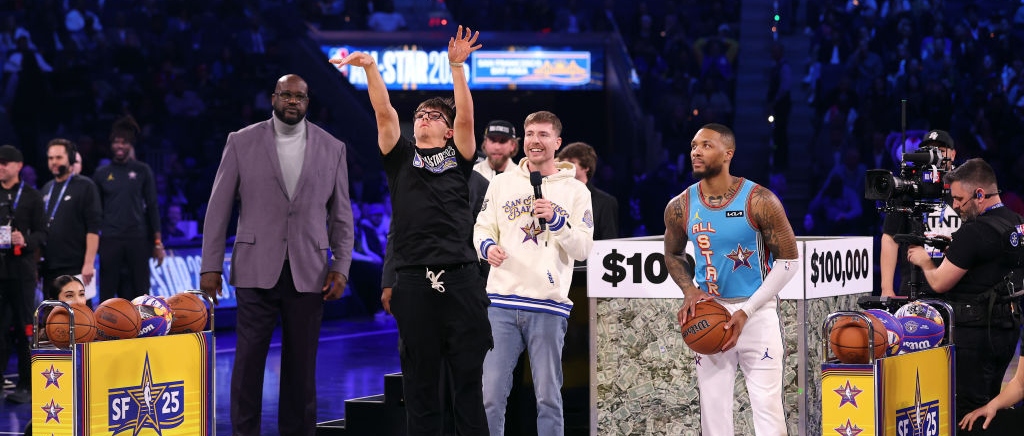To get something out of the way before we dive in: The NBA might have something cooking with its new All-Star Game format. Is it perfect? Absolutely not, but the general idea of how a mini-tournament format would work ended up doing what the league clearly set out to achieve. The games were a little more competitive than the last few years of All-Star, although they weren’t Game 7 of the NBA Finals levels of intense or anything — there were still plenty of uncontested threes and matador defense that led to dunks. The shorter games meant guys didn’t stop caring by halftime. Adam Silver wasn’t visibly furious handing out trophies after the game.
And yet, no one seems to care. This is based on totally anecdotal evidence, but in conversations with people who watched, the NBA’s attempt at reinvigorating the All-Star Game was a total flop. Even beyond conversations with friends or just scrolling X, The Everything App™ and seeing people wonder what the point of all this was, Draymond Green couldn’t hide his disdain on TNT, while players straight up said there were too many stoppages.
Those stoppages were the biggest problem on Sunday night. More broadly, the problem was that the NBA’s solution to its All-Star Game problem — which is, it must be stressed, not a real thing — was to do other things than just playing basketball.
TNT’s coverage of the All-Star Game began at 6 p.m. ET, with the main broadcast beginning at 8:15 p.m. Things went off the air around 11 p.m. That’s right around five hours of coverage. After finding a replay and using the stopwatch on my phone to track just how much basketball there was (i.e., I stopped it for commercial breaks and the Inside the NBA tribute that we will get to), here’s what I found:
Game 1: 13 minutes, 13 seconds
Game 2: 16 minutes, 24 seconds
Game 3: 13 minutes, 49 seconds
I will say that this probably isn’t perfect, just because there were a few times when the desire to have Kevin Hart yell about big men getting into the post outweighed the desire to put the cameras on the game, so I missed a few seconds here and there. Regardless, whether you want to say it was five hours of coverage or 2.5ish hours of the actual event (aside: my goodness, they did not respect the announced start time!), cutting down the amount of basketball to about 43 and a half minutes is completely ridiculous.
The amount of time between games, once again, was a complaint, so I wondered just how much time was spent from the final basket of one game to the opening tip of the next. The time between Game 1 and Game 2 was largely spent watching Mr. Beast yell into a microphone about giving away money, while a chunk of time between Game 2 and Game 3 was spent with a halftime show that was the exact opposite of the Mr. Beast thing, in that it was good and entertaining, a statement that comes with the obvious caveat that I am not the target audience for a Mr. Beast segment. Here are those numbers:
Game 1 to Game 2: 26 minutes, 24 seconds
Game 2 to Game 3: 27 minutes, 25 seconds
There was also the tribute that broke up the championship game. A timeout was taken by Charles Barkley’s team, which found itself down 11-1 at that point, and then, it took 17 minutes and 56 seconds to inbound the ball again. The tribute itself was nice (albeit a little strange due to the fact that Inside the NBA will be on ESPN next year and Turner will continue to broadcast important basketball games for a few more months), but also, this took more time than any of the games! As did the breaks in between them!
Again, compared to the last few All-Star Games, the basketball in this one was pretty good. Victor Wembanyama’s inability to chill added something to his two games (his semifinal more than the final, which we’ll get to in a sec), while the second game — between the Rising Stars winner and the Steph Curry-led team put together by Shaquille O’Neal — was the best of the bunch, because you could tell a collection of All-Stars legitimately did not want to lose to a bunch of young guys who were competing. The third game fell flat, but I think you can argue that’s because Barkley’s team went an hour and 19 minutes from the end of Game 1 to the start of Game 3, and then there was a huge break in the middle of it.
The problem was that basketball — this wonderful game that brought people to the Bay Area in the first place this weekend — never felt like it was the centerpiece. In trying to get fans to believe that the All-Star Game is back, the game of basketball was made to feel less important than ever. Perhaps it should come as no surprise that the gripe for years has been that players don’t take the All-Star Game seriously enough if this is what the NBA thinks it has to do to get them to care. Hell, I think you can make the argument that it’s not surprising that players don’t take All-Star seriously when they’re constantly being made out to be the bad guys for this, sometimes directly by the league.
It’s unfortunate, all of this. I’m not someone who believes the lack of effort in the All-Star Game is an existential crisis — it’s a game that does not count for anything other than the NBA’s ability to have something to sell to media partners and an opportunity for brands to put their logos on things — but I do think that the NBA’s insistence that it is a problem and its never-ending quest to Streisand Effect this into a bigger and bigger deal is a huge issue. Like the never-ending ratings discourse that goes on unabated in spite of the regular season being compelling on a nightly basis and a $76 billion media rights deal, the league’s insistence on responding to every bit of criticism with the hopes that another change will be the thing that makes everyone happy just makes things worse.
The result of this on Sunday was an All-Star Game that wasn’t, a low point for the NBA on an evening where it got exactly what it wanted: Players, on the floor for this event, trying harder than they have over the past few years. You’d be forgiven if that wasn’t your primary takeaway amid everything else that took the spotlight off of the actual playing of basketball at the NBA’s All-Star Game.







